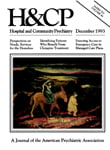Life-Styles, Adaptive Strategies, and Sexual Behaviors of Homeless Adolescents
Abstract
The purpose of this study was to gather information about homeless adolescents, a largely invisible and understudied population. Methods: Highly trained interviewers conducted structured face-to-face field interviews with 93 homeless adolescents between the ages of 13 and 17 in the Hollywood area of Los Angeles. Results: Seventy-nine percent of the sample bad experienced more than one homeless episode in their lifetime, and almost a fourtb reported more than ten episodes. Mean length of time homeless was 440 days ( median of 201 days). Aggressive and violent behaviors, including stealing, destruction of property, and physical fights, were common. The sample had a high prevalence of several mental disorders, including conduct disorder with aggression, major depression, and alcohol and drug abuse. Almost half had attempted suicide. Nearly all the adolescents were sexually active; about a third had more than ten partners in the previous year. About a third reported trading sex for money, foıx1, or drugs. Although most had basic knowledge of HJV transmission and used some form of birth control, little more than halfhad useda condom in the most recent sexual encounter, and 18 percent reported sex with intravenous drug users. Conclusions: Further research on this population is needed, andfollow-up contacts in particular are essential in developing appropriate and successful service programs for them.
Access content
To read the fulltext, please use one of the options below to sign in or purchase access.- Personal login
- Institutional Login
- Sign in via OpenAthens
- Register for access
-
Please login/register if you wish to pair your device and check access availability.
Not a subscriber?
PsychiatryOnline subscription options offer access to the DSM-5 library, books, journals, CME, and patient resources. This all-in-one virtual library provides psychiatrists and mental health professionals with key resources for diagnosis, treatment, research, and professional development.
Need more help? PsychiatryOnline Customer Service may be reached by emailing [email protected] or by calling 800-368-5777 (in the U.S.) or 703-907-7322 (outside the U.S.).



